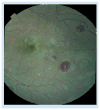Redefining cerebral malaria by including malaria retinopathy
- PMID: 21449844
- PMCID: PMC3139111
- DOI: 10.2217/fmb.11.3
Redefining cerebral malaria by including malaria retinopathy
Abstract
Accurate diagnosis of cerebral malaria (CM) is important for patient management, epidemiological and end point surveillance, and enrolling patients with CM in studies of pathogenesis or therapeutic trials. In malaria-endemic areas, where asymptomatic Plasmodium falciparum parasitemia is common, a positive blood film in a comatose individual does not prove that the coma is due to malaria. A retinopathy consisting of two unique features - patchy retinal whitening and focal changes of vessel color - is highly specific for encephalopathy of malarial etiology. White-centered retinal hemorrhages are a common but less specific feature. Either indirect or direct ophthalmoscopy can be used to identify the changes, and both procedures can be learned and practiced by nonspecialist clinicians. In view of its important contributions to both clinical care and research, examination of the retina should become a routine component of the assessment of a comatose child or adult when CM is a possible diagnosis.
Figures



References
Bibliography
-
- Taylor TE, Fu WJ, Carr RA, et al. Differentiating the pathologies of cerebral malaria by postmortem parasite counts. Nat Med. 2004;10(2):143–145. Demonstrates that retinopathy is the best in vivo predictor of cerebral sequestration of parasitized red blood cells. - PubMed
-
- Poncet F. De la retino-coroidiste palustre. Ann d’Oculistique. 1878;79:201–218. cited in: Looareesuwan S, Warrell DA, White NJ et al Am J Trop Med Hyg 32, 911–915, (1983)
Website
-
- WHO. World Malaria Report. Geneva: WHO; 2009. [Accessed 24 February 2011]. www.who.int/malaria/publications/atoz/9789241563901/en/index.html.
Publication types
MeSH terms
Grants and funding
LinkOut - more resources
Full Text Sources
Medical
